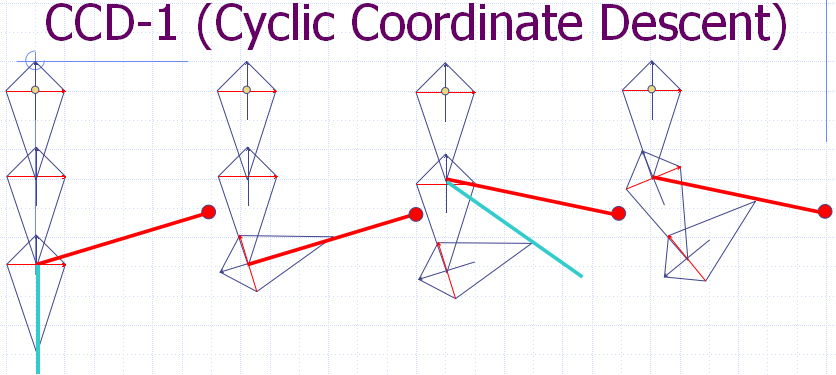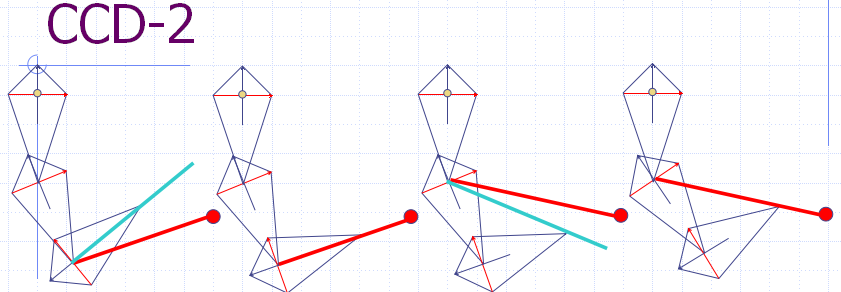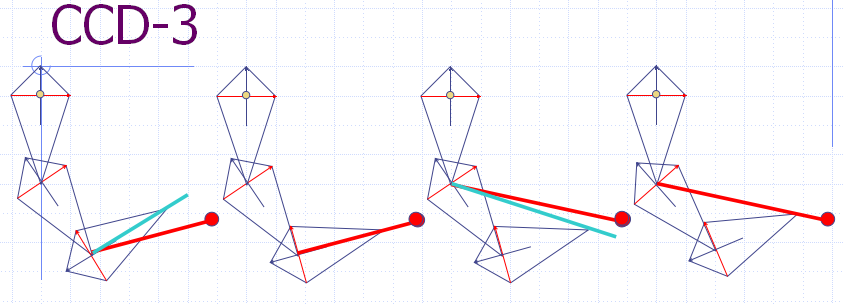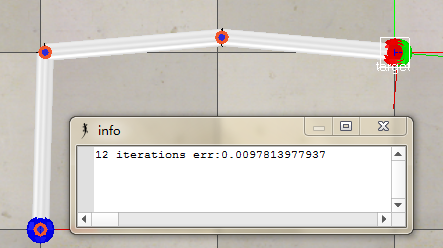V-rep学习笔记:机器人逆运动学数值解法(Cyclic Coordinate Descent Method)
When performing inverse kinematics (IK) on a complicated bone chain, it can become too complex for an analytical solution. Cyclic Coordinate Descent (CCD) is an alternative that is both easy to implement and efficient to process。逆运动学问题一般采用解析法和基于Jacobian矩阵的迭代方法,前者虽然精度高而且能达到实时的效果,但是随着关节的增多,自由度随着增多,数学建模也变得很困难,甚至不可解。而后者很难达到实时的效果。
CCD 算法的思想
Cyclic Coordinate Descent (CCD) 是一个启发式的迭代搜索算法,它通过每一次只改变一个关节的参数来逐步减少位置误差和姿态误差,每个迭代过程包括一个从关节链结构的末端到基点的遍历过程。由于CCD 方法将多关节的关节链问题简化为单关节问题,可以用解析法处理,因此每一步的迭代可以相当快。当求得每个关节的参数 (转角)θ后,将其代入正向运动学方程求得末端效器和每个关节的位置。从运动链的末端开始 , 逐步改变每个关节的旋转角度。先是改变最末端的关节,末端关节到末段执行器的向量为图中蓝色线段,末端关节到目标点的向量为图中红色线段。求出 2 个向量的夹角α,让末端关节下的子链绕旋转轴转α角度,则末端执行器达到一个新位置。若没有达到目标,则继续取当前关节的上一关节,改变其旋转角度,直到选到根节点。若末端还没有达到目标位置,则又从末端关节开始新一轮运动,直到位置误差足够小或者到达了给定的循环次数。
After our first loop through the bone chain, we have moved the end effector much closer to the target position. By repeating this process, we will continue to get closer and closer. Once we have reached a tolerable distance from the target position or once we have performed too many iterations (for performance reasons), we can stop looping.下面三幅图展示了CCD算法的3次迭代过程,可以看出随着迭代的进行,末端离目标点越来越近。



下面在V-rep中建立平面3连杆机构,各杆长均为0.5m,使用Python脚本计算运动学逆解并控制V-rep中的模型,使其达到目标位置。
# -*- coding: utf-8 -*-
import vrep # V-rep library
import sys
import time
import math # This function will convert an angle to the equivalent rotation in the range [-pi,pi]
def ConfineAngle(angle):
angle = angle % (2.0 * math.pi)
if( angle < -math.pi ):
angle += (2.0 * math.pi)
if( angle > math.pi ):
angle -= (2.0 * math.pi)
return angle def CalcIK():
id = linkNum - 1
while id >= 0:
retcode, J_pos = vrep.simxGetObjectPosition(clientID,joint_handle[id],-1,vrep.simx_opmode_oneshot_wait)
retcode, tip = vrep.simxGetObjectPosition(clientID,tip_handle, -1, vrep.simx_opmode_oneshot_wait) # Get the vector from the current bone to the end effector position.
curToEndX = tip[0] - J_pos[0]
curToEndY = tip[1] - J_pos[1]
curToEndMag = math.sqrt( curToEndX*curToEndX + curToEndY*curToEndY ) # Get the vector from the current bone to the target position.
curToTargetX = target[0] - J_pos[0];
curToTargetY = target[1] - J_pos[1];
curToTargetMag = math.sqrt(curToTargetX*curToTargetX+curToTargetY*curToTargetY) # Get rotation
endTargetMag = curToEndMag*curToTargetMag
if endTargetMag <= 0.0001: # prevent division by small numbers
cosRotAng = 1
sinRotAng = 0
else:
cosRotAng = (curToEndX*curToTargetX + curToEndY*curToTargetY) / endTargetMag
sinRotAng = (curToEndX*curToTargetY - curToEndY*curToTargetX) / endTargetMag # Clamp the cosine into range when computing the angle(might be out of rangedue to floating point error)
rotAng = math.acos(max(-1, min(1,cosRotAng)))
if sinRotAng < 0.0:
rotAng = -rotAng q[id] = q[id] + rotAng # Rotate the current link
if(id == 0):
vrep.simxSetJointPosition(clientID,joint_handle[id], ConfineAngle(q[id])+math.pi/2, vrep.simx_opmode_oneshot)
else:
vrep.simxSetJointPosition(clientID,joint_handle[id], ConfineAngle(q[id]), vrep.simx_opmode_oneshot) # Check for termination
retcode, tip = vrep.simxGetObjectPosition(clientID,tip_handle, -1, vrep.simx_opmode_oneshot_wait)
endToTargetX = (target[0] - tip[0])
endToTargetY = (target[1] - tip[1])
error = math.sqrt(endToTargetX*endToTargetX + endToTargetY*endToTargetY)
if( error <= stol ):
# We found a valid solution.
return 1, error
id = id - 1 return 0, error # cannot get to the target in this iteration if __name__ == "__main__":
# Starts a communication thread with the server
clientID = vrep.simxStart('127.0.0.1', 20001, True, True, 5000, 5) # clientID: the client ID, or -1 if the connection to the server was not possible
if clientID != -1: #check if client connection successful
print 'Connected to remote API server'
else:
print 'Connection not successful'
sys.exit('Could not connect') # Exit from Python # Retrieves an object handle based on its name.
errorCode,tip_handle = vrep.simxGetObjectHandle(clientID,'tip',vrep.simx_opmode_oneshot_wait)
errorCode,target_handle = vrep.simxGetObjectHandle(clientID,'target',vrep.simx_opmode_oneshot_wait)
errorCode,consoleHandle = vrep.simxAuxiliaryConsoleOpen(clientID,'info',4,1+4,None,None,None,None,vrep.simx_opmode_oneshot_wait)
joint_handle = [-1,-1,-1] # store the joint handles
for i in range(3):
errorCode,joint_handle[i] = vrep.simxGetObjectHandle(clientID,'j'+str(i+1),vrep.simx_opmode_oneshot_wait) ilimit = 100 # maximum iteration
stol = 1e-2 # tolerance
q = [0,0,0] # initial joint value
linkNum = 3 # number of links retcode, target = vrep.simxGetObjectPosition(clientID,target_handle, -1, vrep.simx_opmode_oneshot_wait)
retcode, tip = vrep.simxGetObjectPosition(clientID,tip_handle, -1, vrep.simx_opmode_oneshot_wait) count = 0
isOK = 0
while ( not isOK ):
isOK,err = CalcIK() vrep.simxAuxiliaryConsolePrint(clientID,consoleHandle,None,vrep.simx_opmode_oneshot_wait)
count = count + 1
vrep.simxAuxiliaryConsolePrint(clientID,consoleHandle,str(count)+' iterations err:'+str(err),vrep.simx_opmode_oneshot_wait) if count > ilimit:
vrep.simxAuxiliaryConsolePrint(clientID,consoleHandle,"Solution wouldn't converge\r\n",vrep.simx_opmode_oneshot_wait)
break
#time.sleep(0.1) # Ends the communication thread. This should be the very last remote API function called on the client side
vrep.simxFinish(clientID)
点击仿真按钮并运行Python控制脚本后,可以看到V-rep中的连杆模型不断调整其关节角,同时误差err逐渐减小。当误差减小到一定程度,就可以停止迭代。下面三幅图中目标处于不同位置,可以发现目标位置对迭代次数有较大的影响(为什么会这样?)



参考:
1.Cyclic Coordinate Descent in 2D :http://www.ryanjuckett.com/programming/cyclic-coordinate-descent-in-2d/
2. 阳小涛 ,杨克俭. CCD 算法及其在逆运动学中的应用与实现[J]. 重 庆 工 学 院 学 报 (自然科学),2008 年 5 月
V-rep学习笔记:机器人逆运动学数值解法(Cyclic Coordinate Descent Method)的更多相关文章
- V-rep学习笔记:机器人逆运动学数值解法(The Jacobian Transpose Method)
机器人运动学逆解的问题经常出现在动画仿真和工业机器人的轨迹规划中:We want to know how the upper joints of the hierarchy would rotate ...
- V-rep学习笔记:机器人逆运动学数值解法(The Pseudo Inverse Method)
There are two ways of using the Jacobian matrix to solve kinematics. One is to use the transpose of ...
- V-rep学习笔记:机器人逆运动学数值解法(Damped Least Squares / Levenberg-Marquardt Method)
The damped least squares method is also called the Levenberg-Marquardt method. Levenberg-Marquardt算法 ...
- V-rep学习笔记:机器人逆运动学解算
IK groups and IK elements VREP中使用IK groups和IK elements来进行正/逆运动学计算,一个IK group可以包含一个或者多个IK elements: I ...
- matlab学习笔记10_6 字符串与数值间的转换以及进制之间的转换
一起来学matlab-matlab学习笔记10 10_6 字符串与数值间的转换以及进制之间的转换 觉得有用的话,欢迎一起讨论相互学习~Follow Me 参考书籍 <matlab 程序设计与综合 ...
- ES6学习笔记(四)-数值扩展
PS: 前段时间转入有道云笔记,体验非常友好,所以笔记一般记录于云笔记中,每隔一段时间,会整理一下, 发在博客上与大家一起分享,交流和学习. 以下:
- python学习笔记(五)数值类型和类型转换
Python中的数值类型有: 整型,如2,520 浮点型,如3.14159,1.5e10 布尔类型 True和False e记法: e记法即对应数学中的科学记数法 >>> 1.5e1 ...
- ES6学习笔记(四)数值的扩展
1.二进制和八进制表示法 ES6 提供了二进制和八进制数值的新的写法,分别用前缀0b(或0B)和0o(或0O)表示. 0b111110111 === 503 // true 0o767 === 503 ...
- Python学习笔记(2)数值类型
进制转换 int函数任意进制转换为10进制 第一个参数传入一个字符串,任意进制的,第二个参数传入对这个字符串的解释,解释他为几进制 hex oct bin转换进制为16 8 或者2进制 例题中石油87 ...
随机推荐
- C# PDFBox 解析PDF文件
下载 PDFBox-0.7.3.zip PDFBox-0.7.3.dlllucene-demos-2.0.0.dlllucene-core-2.0.0.dllbcmail-jdk14-132.dllb ...
- scala构建类似java的pojo
主要看以下代码: package com.test.scalaw.test.demo import scala.beans.BeanProperty /** * scala构建类似java 的pojo ...
- 如何获取各大平台的播放地址(获得优酷的m3u8播放地址)为例
1.打开safari 2.在顶部(黑色小苹果)旁边,点击safari. 3.打开里面的 偏好设置. 4.在高级 中 找到 “在菜单栏中显示开发菜单” 并打勾. 5.关闭窗口后,可以发现safari 顶 ...
- PHP获取客户端真实IP的自定义函数
<?php //虽然使用 $_SERVER[REMOTE_ADDR] 也可以获取,但是要获取真实的客户端IP地址,需要使用下面的方法: function _getIP(){ $ip=getenv ...
- svn搭建以及可能遇到的问题解决方案
Svn服务器的安装和配置 1.安装svn服务器端软件从镜像服务器或者YUM源下载安装SVN服务器软件:yum install subversion mkdir /usr/local/svn //创建S ...
- Codeforces 743D:Chloe and pleasant prizes(树形DP)
http://codeforces.com/problemset/problem/743/D 题意:求最大两个的不相交子树的点权和,如果没有两个不相交子树,那么输出Impossible. 思路:之前好 ...
- Cocos2dx中的opengl使用(一)简单介绍
引擎提供了CCGLProgram类来处理着色器相关操作,对当前绘图程序进行了封装,其中使用频率最高的应该是获取着色器程序的接口:const GLuint getProgram(); 该接口返回了当前着 ...
- 杭电1019-Least Common Multiple
#include<stdio.h>int gcd(int a,int b);int main(){ int n,m,a,b,i,sum;//sum是最小公倍数 scanf(&q ...
- Javascript中最常用的经典技巧
1. oncontextmenu="window.event.returnValue=false" 将彻底屏蔽鼠标右键<table border oncontextmenu= ...
- javaWEB国际化(jsp中使用)
在jsp页面中使用国际化方法,首先将jstl开源架包:jstl.jar,standard.jar导进去 并在src目录下建立以test开头,.properties结尾的文件:test_en_US.pr ...
